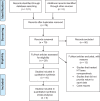Return to Sport After Proximal Hamstring Tendon Repair: A Systematic Review
- PMID: 31259189
- PMCID: PMC6591667
- DOI: 10.1177/2325967119853218
Return to Sport After Proximal Hamstring Tendon Repair: A Systematic Review
Abstract
Background: Previous studies have evaluated functional outcomes and return-to-sport rates after proximal hamstring tendon (HT) repair.
Purpose: To systematically review the literature in an effort to evaluate return-to-sport rates after proximal HT repair.
Study design: Systematic review; Level of evidence, 4.
Methods: A systematic review was performed by searching PubMed, the Cochrane Library, and Embase to identify studies that evaluated postoperative lower extremity function and return-to-sport rates in patients after proximal HT repair. Search terms used were "hamstring," "repair," "return to sport," and "return to play." Patients were assessed based on return to sport, return to preinjury activity level, type of HT tear (complete or partial), and interval from injury to surgery. Patients were also divided into subgroups depending on timing of the surgical intervention: early, <1 month; delayed, 1 to 6 months; and late, >6 months from the time of injury.
Results: Sixteen studies (one level 2, five level 3, ten level 4) met the inclusion criteria, including 374 patients with a complete proximal HT tear (CT group) and 93 patients with a partial proximal HT tear (PT group), with a mean follow-up of 2.9 years. Overall, 93.8% of patients (438/467) returned to sport, including 93.0% (348/374) in the CT group and 96.8% (90/93) in the PT group (P = .18). The mean time to return to sport was 5.7 months, and 83.5% of patients (330/395) returned to their preinjury activity level. The early group demonstrated the greatest rate of return to sport at 94.4% (186/197) as well as the quickest time to return at a mean of 4.8 months, although this was not found to be statistically significant.
Conclusion: Over 90% of patients undergoing repair of a complete or partial proximal HT tear can be expected to return to sport regardless of the tear type. Early surgical interventions of these injuries may be associated with a quicker return to sport, although the rate of return to sport does not differ based on timing of the surgical intervention.
Keywords: complete tear; hamstring tendon repair; partial tear; return to sport.
Conflict of interest statement
One or more of the authors has declared the following potential conflict of interest or source of funding: O.M.-D. has received nonconsulting fees from Arthrex, has received educational support from Arthrex, is a consultant for Stryker and Smith & Nephew, and receives royalties from Stryker. E.C.M. has received nonconsulting fees from Biomet, receives royalties from Zimmer Biomet, and is a consultant for DePuy and Zimmer Biomet. M.K.M. has received educational support from Arthrex and Quest Medical and has received hospitality payments from Biomet and Zimmer. AOSSM checks author disclosures against the Open Payments Database (OPD). AOSSM has not conducted an independent investigation on the OPD and disclaims any liability or responsibility relating thereto.
Figures
References
-
- Birmingham P, Muller M, Wickiewicz T, Cavanaugh J, Rodeo S, Warren R. Functional outcome after repair of proximal hamstring avulsions. J Bone Joint Surg Am. 2011;93(19):1819–1826. - PubMed
-
- Bodendorfer BM, Curley AJ, Kotler JA, et al. Outcomes after operative and nonoperative treatment of proximal hamstring avulsions: a systematic review and meta-analysis. Am J Sports Med. 2017;46(11):2798–2808. - PubMed
-
- Bowman KF, Jr, Cohen SB, Bradley JP. Operative management of partial-thickness tears of the proximal hamstring muscles in athletes. Am J Sports Med. 2013;41(6):1363–1371. - PubMed
-
- Chahal J, Bush-Joseph CA, Chow A, et al. Clinical and magnetic resonance imaging outcomes after surgical repair of complete proximal hamstring ruptures: does the tendon heal? Am J Sports Med. 2012;40(10):2325–2330. - PubMed
-
- Cohen SB, Bradley J. Acute proximal hamstring rupture. J Am Acad Orthop Surg. 2007;15(6):350–355. - PubMed
Publication types
LinkOut - more resources
Full Text Sources
Miscellaneous


